The Tefillin Wars of Tel Aviv

A battle of ideals and identity
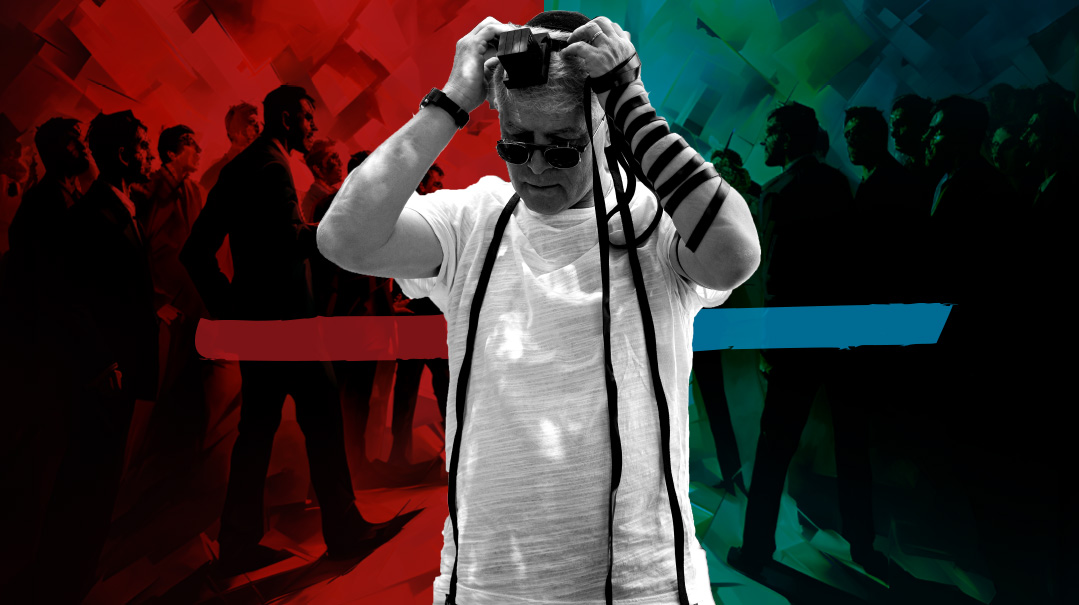
Photos: Elchanan Kotler, Flash 90
IN Israel’s liberal capital, an illiberal wind is blowing as avowed secularists furiously turn on Tefillin and public displays of Jewish practice as missionary activity. From the Shuk to Dizengoff and Habima Square, weeks of conversations with Tel Avivians of all stripes lead to one conclusion: the battle over the Tefillin stands is a microcosm of the battle for Jewish identity today
It was a Friday afternoon in early June, and in the shadow of the famous theater that gives Tel Aviv’s Habima Square its name, a mild-mannered Chabad bochur manning a pop-up booth offered the largely secular passersby his wares — the chance to put on tefillin.
For Philadelphia-born Shlomo Gerber, this was a regular Erev Shabbos activity, carried out after Friday morning seder in the nearby Chabad yeshivah in the city center. But after months of fevered left-wing protests against the Netanyahu government’s signature justice reforms, the simple routine had put him on someone’s radar.
While two secular teens came over to Gerber’s stand and began to put on tefillin, a woman marched up, camera in hand and contempt in her voice.
“You know that this is forbidden by law?” she barked at the shaliach, waving aside his friendly offer of Shabbos candles, and turning to the boys.
“How old are you?” she demanded of one teen. “I’m fourteen,” he answered politely, adding, “we approached him on our own.”
But the faceless antagonist — holding the camera away so that only her voice was picked up — grew more aggressive.
“Did he promise you anything to get you to do that — candies, or something?” she demanded. “You know that this is forbidden by law, because you’re a minor.”
“They want to do a mitzvah like all Jews want to do a mitzvah,” the shaliach attempted to break in, winding away the tefillin and keeping his cool.
“Be quiet! I wasn’t talking to you,” the woman snapped before concluding with a final warning. “It’s forbidden by law to use religious coercion on any of these children. Never approach another child again — you’ll end up in prison!”
It was bigotry at its ugliest — all the more chilling for being inflicted by one Jew on another in the heart of one of the biggest Jewish cities in the world. Predictably, the video of the incident proved a social media sensation, although much of it not of the kind that the left-wing activist had hoped. Within hours, it had triggered an outpouring of condemnation as celebrities and news site commenters weighed in, in defense of the Chabadnik.
“What’s your problem? It’s just tefillin,” posted one influencer.
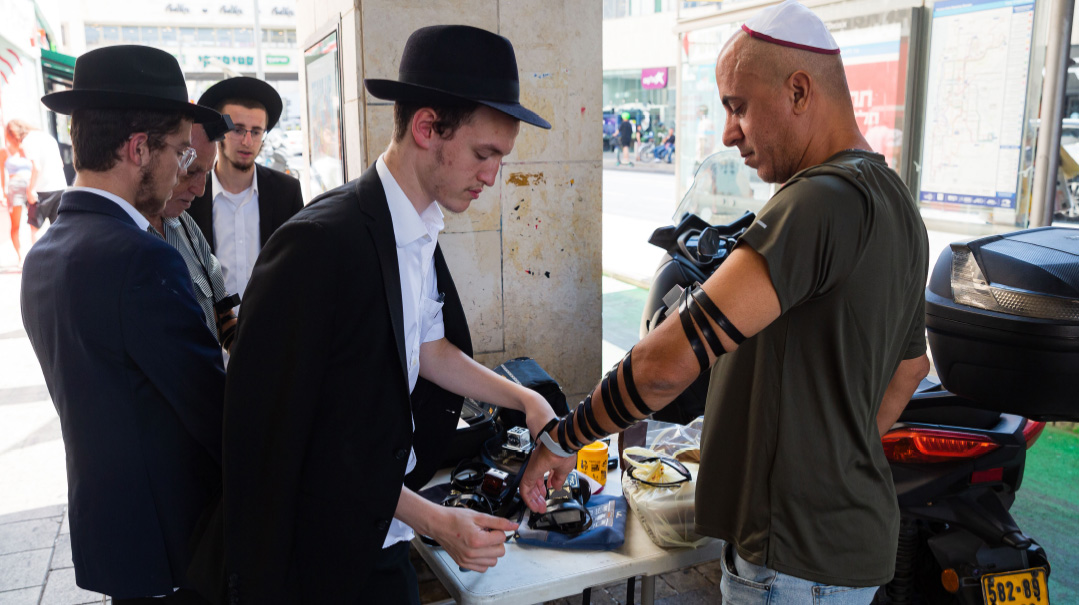
“It’s shocking,” wrote a famous comedian. “I’m not religious, but Chabad are Israel’s real Foreign Ministry, and they’re always there for you when you go overseas.”
A talkback on a right-wing news site was more cutting: “The lefties are okay with children changing their biological identity at age nine, but 14-year-olds can’t choose to put on tefillin.”
Like a host of previous incidents involving hostility to religious life, the controversy peaked with a flood of secular teens at tefillin stands in Tel Aviv and beyond, before the news cycle moved on.
In one sense, the incident was just another social media outrage fest in the long trail of provocations and religious bating that has defined Israel’s worse societal clash in memory. There’s a certain predictable formula to the encounters that have been about children reduced to tears by anti-reform protesters, a chareidi man berated for not serving in the army, or a religious beggar faulted for his indigence because of his supposed refusal to earn a living. First comes the viral outrage, then support or condemnation from public figures on the relevant side, followed by some media airtime, and then the circus moves on.
But to many observers, the Habima incident went beyond the left-right sniping that has dogged public discourse over the last year. Deep into the country’s Indian summer of political discontent, its hard to find anyone who believes that the turmoil is about the finer points of parliamentary democracy and the separation of powers. Rather, it’s clear that at heart the struggle over justice reform is an almighty tussle over Israel’s identity — hence its vitriol.
Religious or secular, conservative or liberal, particularistic or universalist, democratic first or Jewish first — the most convulsive debate in generations about Israel’s future is now being hashed out in the media, the Knesset, and the streets.
Amid that Kulturkampf, the Tefillin Wars of Tel Aviv are a stark metaphor for those deep questions of identity. Secular Tel Aviv — Ground Zero for the protest movement — is not so much a brick-and-mortar city, but an idea; a symbol of the free-wheeling liberalism that the protest movement champions.
In that battle of ideas, the tefillin stands that have mushroomed all over Israel courtesy of Chabad and other outreach organizations, are themselves a metaphor. What all sides intuit is that the act of publicly donning tefillin is the ultimate expression of a newfound interest in Jewish tradition that is challenging the secular hegemony over the IDF, popular culture and the public square, and in the process, rattling the old left-leaning elites.
In the aftermath of the Habima incident, I head to Tel Aviv for the first of a series of encounters on the front lines of the Tefillin Wars. Weeks reporting on the phenomenon, talking to everyone from shoppers to philosophers, make it clear that the clash over “Dat U’Medinah,” as the question of religion in public life in Israel is known, is a central part of the identity struggle.
To the shaven-headed teens I encountered with their husky professions of Jewish devotion, posting a tefillin selfie is an expression of faith — both in Hashem, and the country’s Jewish nature. For the left-wing activists battling to rescue their city and country from that very fate, those selfsame tefillin stands are the front line in a war that they have to win. Neither side will give way, and so the battle is on.
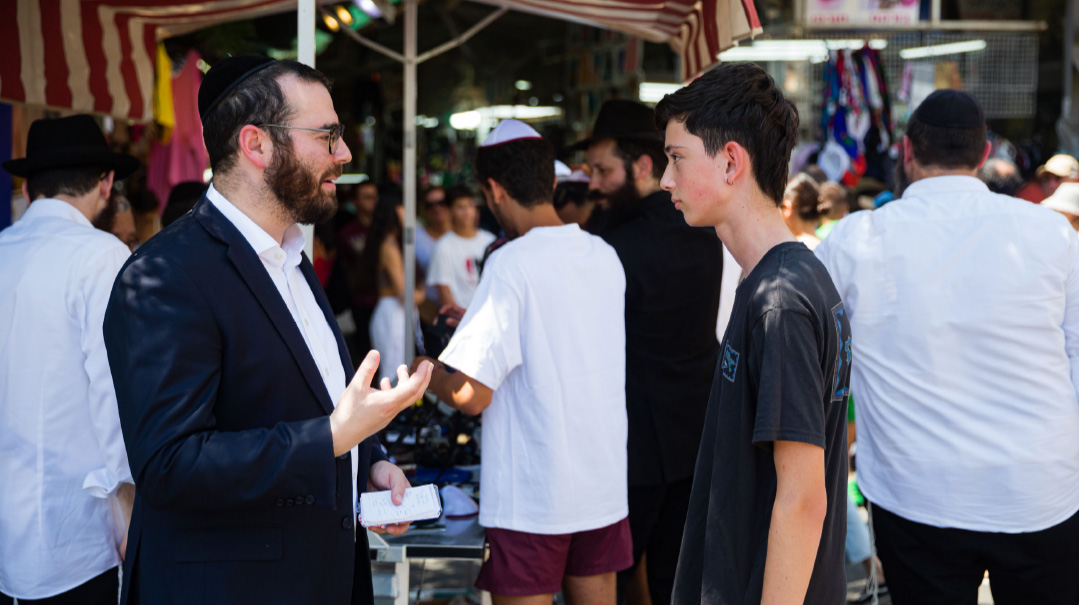
“I’m the religious one of the family” The experience of Yonatan, 16 from Zichron Yaakov is part of a picture of growing traditionalism among Israeli teens
Phylactery Factory
Amid the riot of color and movement that is Tel Aviv’s Shuk HaCarmel on a Friday morning in late summer, the reggae artist standing in the broad square in front of the marketplace takes center stage. Belting out his repertoire in a throaty West Indian voice for more than two hours, he seems tireless. As crowds throng into the square from the artists’ market along Nachalat Binyamin Street, he draws smiles and an appreciative audience.
It’s a distinctly Tel Avivian scene. Anywhere else in Israel, the busker might have merited a few spectators and a handful of coins dropped into a guitar case. But in the city that prides itself on living life to the full, the singer is feted by a 50-strong crowd, with seemingly nothing better to do on a Friday morning than sing along to some reggae classics.
Against that freewheeling backdrop, a bus full of Chabad shlichim — avreichim, bochurim, women and girls — arrives to turn Tel Aviv’s largest market into an outdoor shtibel.
Their setup is something like a military operation, with tefillin stands strategically located at every one of the shuk’s entrances, making it impossible for a shopper to evade an encounter with the troops from Kfar Chabad, handing out their supplies of tefillin or Shabbos candles.
Commanding the operation is Moishie Fleischman, a genial man with a quick smile, a bear hug, and a bird’s-eye view of the whole setup.
“We are here every summer Friday in shifts, from 9 a.m. to 4 p.m.,” he says, “and over the seven tefillin stands, there are normally about 400 people who come to put on tefillin, which means that on average it works out as one Jew a minute putting on tefillin.”
Fleischman greets passersby, triggering an amusing response from multiple men: they lift up their arms to display fresh tefillin marks. “Those marks are like their passport — they know that they can pass by us now,” smiles another young man working out of Fleischman’s large stall.
Mid-conversation, Moishie Fleischman spies a likely-looking target — a young, secular-looking couple whose dark skin is testament to their Mizrachi background, and likely openness to tradition.
“Ach sheli,” he hails the man, “hinachta tefillin hayom?”
Despite the newcomer’s lack of kippah, Fleischman has chosen well. Yaniv and Mor are from Migdal HaEmek, a northern town famed for its religious revival led by Rav Yitzchak Dovid Grossman.
The encounter is one of many with non-Tel Avivians that take place over the course of the morning. Like a pair of giant lungs, the city inhales and exhales visitors twice a day. Millions of Israelis arrive in the daylight hours to work and shop in the country’s business capital, and by night to soak in the nightlife and café culture.
Mor looks on proudly as Yaniv puts on tefillin, says Shema fluently, and thanks his host. As the couple prepare to leave, I flash my journalist’s card and strike up a conversation. “Why did you stop to put on tefillin,” I ask, “and what do you think of the recent controversy about tefillin booths such as this in Tel Aviv?”
Yaniv looks offended at the very question. “Achi,” he chides in the half-familiar, half-condescending tone of one not sure how to explain the obvious to a fool. “We’re traditional. I often put on tefillin. We don’t force anyone to be religious, but this is a Jewish country. End of story.”
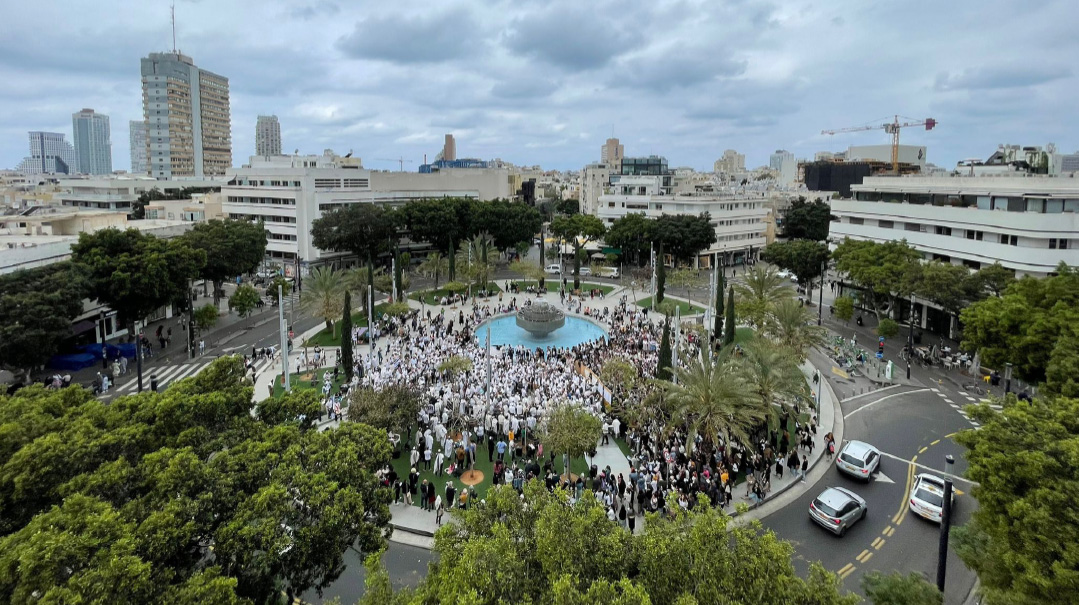
Amid the anti-religious hysteria that has gripped some secularists, a mechitzah at a public Tefillah is verboten. Pictured here is Rosh Yehudi at Dizengood Square last year, just before the onset of Yom Kippur
Belief System
For Ariel and Yoni, a father and son from a kibbutz in the north, things aren’t quite so clear cut, though. They’ve arrived to put on tefillin, but as Ariel says, their friends back home wouldn’t look so kindly on the public practice of religion. “I’m not a typical kibbutznik,” Ariel explains. “I grew up religious, and went to a religious high school in Jerusalem before I married my wife who was from the kibbutz.”
That “I’m not a typical secularist” is a common theme for many on the borderlands of secularism and tradition. According to a 2020 Government Statistics Office survey, self-declared “mesorati’im” (or traditional Jews, outwardly secular but who maintain different aspects of Jewish practice) constituted 33 precent of the country’s Jewish population. But in a sign of the fluidity of the category, a recent report from the Jewish People Policy Institute noted that when offered the further subcategories of “secular-traditional” or “religious-liberal,” only 19 percent of respondents defined themselves as purely traditional.
The increased traditionalism of Israeli life is obvious everywhere outside of staunchly secular bubbles like north Tel Aviv. The large religious population of places such as south Tel Aviv and Eilat are clear evidence of a shift. Numbers also do a good job of tracking less tangible aspects of the change.
A decade ago, the Israel Democracy Institute, a Jerusalem-based think tank, released a survey about faith in Israel, which reported that 80 percent of Israeli Jews — including the 46 percent who defined themselves as secular — said that they believed in G-d. Further, 67 percent believed in the concept of the Chosen People, and 65 percent believed in the Divine origin of the mitzvos. In response, the secular Ha’aretz newspaper headlined, “The secular majority is no more,” and explained that, “This is no longer popular veneration of traditional customs, but of belief. Three out of four Israelis are not atheists.”
Yonatan, a serious-faced 16-year-old from Zichron Yaakov who wasn’t wearing a kippah before he approached the booth, is a good example of this growth of tradition among hitherto secular Jews.
“I put on tefillin a few times a week,” he tells me shyly. “It’s not from school or home — I’m the religious one of the family. I don’t know why — I’m just attracted to it.”
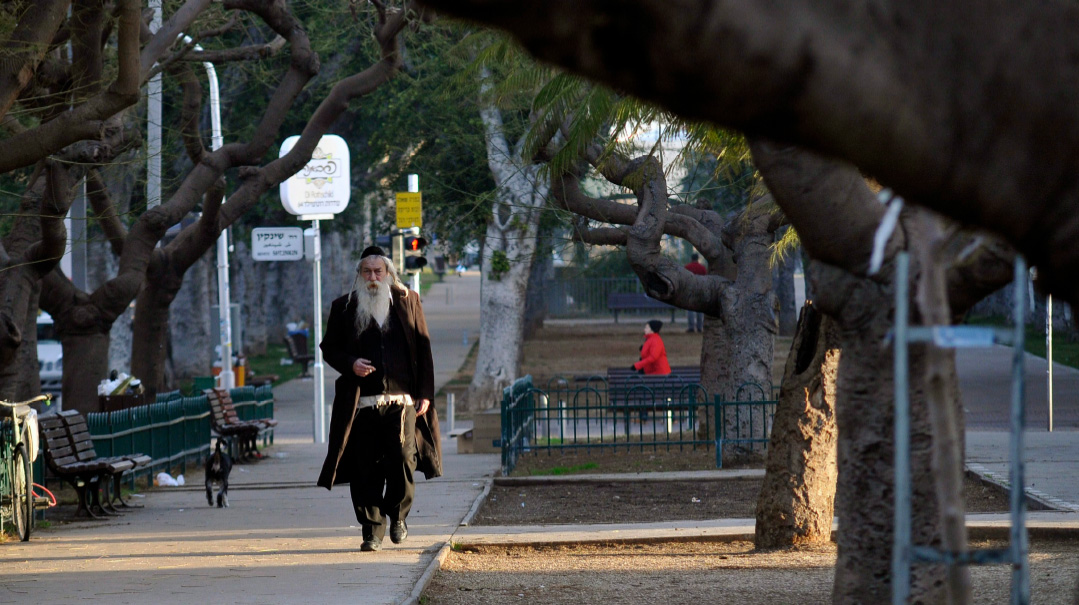
“Not a secular city” Tel Aviv once boasted more chassidic courts than Bnei Brak
Hot Mic
A short distance away from Moishie Fleischman’s stall at another entrance to the market square, a slightly younger crew mans a booth around which four young boys of 12 and 13 are eagerly clustered. They’re from prosperous Ra’anana, and the roughness of their blond-highlighted hair and assorted earrings is belied by their still-innocent baby faces.
“It’s a trend now, to post pictures wearing tefillin,” says one of them eagerly. “We all try to do it once a week.”
Barely more than children, they eagerly chatter about school, religion, and their homes when they’re interrupted by a repeat of the very same performance captured on the cellphone clip in Habima Square.
“What are you doing — why are you brainwashing those children?!” a middle-aged secular woman yells at the Chabad men as she walks past the stall.
The response is identical to the viral clip, as the shocked boys first stay silent and then find their voices: “We chose to put on tefillin ourselves — no one forced us!” says one of the boys.
As if it’s an unpleasant reality of their job description that they’ve been trained to cope with, the avreichim keep quiet and don’t answer back, but the woman isn’t finished.
Ignoring the fact that the boys came of their own free will, she fires a parting shot: “How would you like it if I came to your areas and tried to convince your kids to follow my way of life?”
The irate woman — apart from her outburst, perfectly ordinary-looking — refused a request to talk, and disappeared into the crowd. But her words don’t leave the people around unmoved.
“It’s a terrible thing,” says one secular woman from Modi’in, who’d brought her strapping soldier grandson over to the stand. “You don’t have to keep Judaism, but this is our tradition.”
“Kol Hakavod to these Chabadnikim,” say another older couple walking past. “Look how they go out of their way to help everyone.”
“Just ignore it,” a man with a long, greasy ponytail advises. “There are only a few people like that.”
The latter may be correct that only a small number of people will ever be motivated to make a public scene, but the fact remains that tefillin for young teens seems to be a particular flashpoint.
A quick Google search shows that both sides of the “tefillin in school” issue occurs so frequently it’s almost a meme. For example, back in 2020, there was a minor storm from secular parents in Tel Aviv who complained that their children were being “trapped” into putting on tefillin by Chabad, which had stands outside the schools. The Municipality was forced to issue a clarification that a local bylaw forbade siting a tefillin stand within 100 meters of a school.
A similar controversy broke out this year in Rishon L’Tzion, where a 16-year-old was reported to have been suspended by the principal of his secular high school for organizing a tefillin stand inside the school. Once again, politicians and commentators of all stripes weighed in.
It’s a pattern of high-decibel outrage stretching back years. In 2007, then-Shas Minister Shlomo Benizri raised the issue in the Knesset after an Eilat principal reportedly forbade a teen from laying tefillin in school.
In the Knesset committee debate, there were all the elements that are prevalent today: anguished expressions of, “How can this happen in a Jewish country,” on one side and, “How dare you threaten our secularism,” on the other.
Back in Shuk HaCarmel, Moishie Fleischman puts the unpleasant episode in context: any animosity comes from a small minority; if anything, he says the public controversy is good for business. “Immediately after one of these incidents, the number of people wanting to put on tefillin jumps as an act of protest.”
Old Elites
Habima Square is only a few traffic-choked miles north of the shuk in Tel Aviv, but it’s a very different world. It’s less Middle East, more Middle Europe. In place of the spices and haggling, café patrons sit around the large square with its water fountains, sipping lattés.
I’m here for a meeting with Shlomo Gerber and his tefillin stand of viral fame.
“Unlike other more traditional areas of Tel Aviv, many people won’t come forward and actively look to put on tefillin,” he says. “About half of them only do so after you ask, but when people ride past on a scooter or bike and you offer the opportunity, about ten percent will take you up on it. These are people who may not have put on tefillin for 20 years, but their neshamah suddenly wakes up.”
Although he retains the Chabad optimism and is reluctant to categorize demographics into more or less traditional, it’s clear that Habima isn’t the easiest assignment. “There are one or two people every week who would make comments like, ‘Go back to Bnei Brak,’ and once in a while people get annoyed at being offered the chance to put on tefillin, but it takes two to fight, and if you don’t answer back then they leave you.
“In general, when people make negative comments it encourages others to do the mitzvah — this woman who screamed caused so many others to do a mitzvah,” he concludes on an upbeat note.
Here in Habima Square, it’s hard to miss the very different feel and challenges of operating in this part of Tel Aviv. Habima, as it’s known, is home to the country’s premier cultural institutions: Heichal Hatarbut, which hosts the Israel Philharmonic Orchestra; Habima Theater, and a contemporary art museum.
Habima — Israel’s national theater — is a storied institution. Founded in Moscow in 1917, it hailed from the age of Hebrew and Yiddish theater, which was birthed by Russia’s secular Jewish intelligentsia. The bronze busts of Habima’s Russian founders are a reminder of just how deep are the cultural roots of Israel’s secularism. In many ways, the Tefillin Wars of today play out the clashes around Jewish practice that plagued the Eastern European Jewish communities of yore, with today’s chilonim taking the place of the maskilim of yore.
The other fact that’s immediately noticeable in this bastion of elite culture is that the patrons are overwhelmingly members of what Israelis call the “Shevet Lavan” — the white, secular Ashkenazi tribe.
It’s a reminder that the identity struggle playing out in the judicial reform protests has a strong ethnic component — a point made by historian and commentator Dr. Gadi Taub in a powerful piece in Tablet magazine.
“Imagine an America where the ‘MAGA deplorables are African American, and you have a good idea of what’s happening in Israel,” Taub wrote. “Netanyahu’s voters are typically darker-skinned Mizrachi Jews, and so Israel’s progressives often play on ethnic and racial stereotypes to express their scorn for the right.”
One of many examples of the casual scorn heaped by Israel’s progressive elite on Sephardim was an infamous comment by Dana Weiss, a news anchor, to Likud Minister Dudi Amsalem, who is of Moroccan extraction, telling him in one interview to “stop talking with his hands.”
“Imagine an American white female anchor correcting a Black man’s manners on air as if he were a child in need of discipline,” says Taub. “She would, most probably, be out of work the next day. But in Israel, this view of the Mizrachim as inferior is part and parcel of the narrative that says democracy must be saved from the wild hordes.”
Taub has been thinking about the clash now manifesting on Israel’s streets for a long time. The roots of the conflict are the subject of his 2020 book “Nayadim V’Nayachim” — a clever play on the words for cellphones and landlines — which divides Israeli society into a footloose cosmopolitan elite (the Nayadim) and a patriotic, rooted majority (the Nayachim).
So how does a conflict with ethnic overtones line up with the religious-themed strife manifesting in the Tefillin Wars?
“What’s going on in Israel is the same struggle that’s taking place all over the West,” Taub answers. “National identity is under siege from globalist elites who turn their backs on fellow citizens. They see themselves as closer to the upper classes across the West than to their own kin.
“In Israel, that takes the form of a struggle over the Jewish character of the state. It’s not a new struggle: historically there have always been movements that have attempted to universalize the moral component of Judaism. In the Roman period, a Jewish elite wanted to join the Pax Romana, which was that era’s form of a universal culture. The amazing percentage of Jews in the Bolshevik movement was again due to that universalistic tendency. Today’s progressive Jewish elite with their emphasis on the universalistic idea of Tikkun Olam as opposed to Jewish nationalism is a modern manifestation of the same dynamic.”
By virtue of his upbringing in a home that mourned Menachem Begin’s 1977 victory, and his academic and cultural accomplishments — he’s also a bestselling novelist — Taub ought to be a fully-paid up member of the footloose global elite. But in a process something akin to Irving Kristol’s maxim that a “neoconservative is a liberal who has been mugged by reality,” Taub has drifted right. What does he think of the hysterical reaction to teens putting on tefillin in Habima and Shuk HaCarmel?
“It’s an attempt to portray a fundamental part of Jewish practice as somehow dangerous, seducing our children into cult-like behavior, and you have to ask yourself — where does this hysterical fear come from?
“It’s because the old secular elites feel sociologically besieged. They look at the demographics, at the religious populations growing rapidly. These elites feel that Israel is their country and sense that they are losing ground. They fear that all the barbarians, the unenlightened hordes of messianists, Mizrachim and traditionalists will impose a Middle Ages theocracy and that their own future is doomed. This is of course, absurd.”
Outside Influences
It’s the first night of Rosh Hashanah, and in a large old shul behind Dizengoff Center in the geographical midpoint of the city, a big group of those unenlightened messianists are gathered. Because it’s Friday night, and the minyan is nusach Sefard seasoned by a heavy dose of Carlebach spirit, there’s singing and dancing along with the Rosh Hashanah feeling in the air.
The crowd — many clad all in white, some sporting earrings and other bits of secular paraphernalia — settle down to listen to an overview of Rosh Hashanah. The speaker, Yisrael Zeira, shares some ideas about the different dimensions of teshuvah and then turns to important announcements.
“Tomorrow later afternoon, there’ll be Tashlich in our normal spot on the beach, and on Yom Kippur we’ll be joined by large numbers of our neighbors at our open air Tefillah in Dizengoff Square. Come and join us messianics!” Zeira ends, ironically, drawing appreciative laughter from the 100-strong audience in the shul.
The reference wouldn’t have been lost on anyone who’s spent time in central Tel Aviv. Zeira is the founder of Rosh Yehudi, a large outreach organization that follows Rav Kook’s ideology, and has been very successful at drawing close many secular Israelis in Tel Aviv.
Founded by Zeira — a real estate developer by profession — in the wake of the Rabin assassination, Rosh Yehudi was part of a strategic reentry into Israel’s economic and cultural hub by the National-Religious community that included the founding of a hesder yeshivah — Maaleh Eliyahu in Tel Aviv, as well as an equivalent in adjacent Ramat Gan.
“The vitriol directed at the dati-leumi community after Rabin’s murder by secular Jews was a wake-up call for the community, which had left the city in the 70s to live in places like Ra’anana, and Yehudah and Shomron. We discovered that we had ‘lost’ secular Israel,” he says.
The reentry plan involved bringing young families in to live in the city — a strategy followed to this day with multiple religious families living in the heart of secular Tel Aviv and maintaining a vibrant shul and network of midweek learning opportunities.
Given the organization’s strategic goals for reclaiming the city, part of Rosh Yehudi’s approach is to maintain a vigorous religious presence in the city’s public spaces, drawing everything from Kol Nidrei to hakafos sheniyos into a joyful outdoor celebration of Torah life. These events, of course, require a mechitzah — a big, retrograde no-no for the powers that be in the progressive city.
In the eyes of Tel Aviv’s secular hardcore, those activities are enough to earn the organization the dreaded moniker of “messianic,” and a place on the Mizrach wall of the Tefillin Wars.
That status came to a head on Tu B’Av, during which Rosh Yehudi together with Hidabroot — a large kiruv organization — cohosted a tefillin event in Habima Square in honor of the World Tefillin Day. The full day event, which included everything from inflatable toys for kids, free food, a concert and tefillah plus shiurim, raised secularist hackles for daring to step into the public space.
A local entertainment website whose current affairs coverage is limited to Tel Aviv’s religious strife, reported that “the missionary organizations ‘Rosh Yehudi’ and ‘Hidabroot’ would celebrate Valentine’s Day, commonly known as ‘Tu B’Av,’” colliding head-on with a secular counter-event in Habima, featuring inflatables, free food, and music (with female singers).
In fact, the sparsely-attended counter provocation achieved little of substance: a few women activists tried to join the large Rosh Yehudi dancing circle, and after being ignored, went away.
But with a militantly secular municipal leadership under Mayor Ron Huldai, the secularist provocateurs achieved one significant victory: banning the planned mechitzah, which the Municipality has ruled discriminatory and illegal.
The ruling set a precedent for Yom Kippur: at press time, Huldai was standing firm on his mechitzah ban for Yom Kippur, condemning the mass outdoor tefillah that draws many secular locals, and which has become a local tradition.
The shocking ban — which is being appealed in court — has drawn international Jewish condemnation, and disbelief from locals who note the liberalism to other faiths that Tel Aviv embraces.
“Just a few months ago, Huldai’s Municipality allowed a mass gender segregated Muslim prayer rally in Charles Clore Park,” notes Yisrael Zeira. “Why is the city less liberal to us?”
Zeira — who has operated in the city for a quarter-century, and moved to it six years ago — says that over the last year, he’s been witness to a displays of hatred that he wouldn’t have dreamed possible.
Shortly after Rosh Hashanah, that hatred was on display for the world to see in a viral video, as Zeira had to be rescued by police from a crowd of far-left anarchists who targeted a Rosh Yehudi event in Dizengoff Square.
“Fascists in kippot!” was one of the less vulgar epithets hurled at the religious group. “Tribe of Yehuda, we’ll drive you out of here,” went another, a reference to the secular calls for autonomy for Tel Aviv from the rest of Israel.
That type of hatred has been on display for a year now. “Every Shabbos Minchah, the protesters gather in Kikar Dizengoff — adjacent to our shul — and head from there to Kaplan Street, the focus of the anti-overhaul protests,” says Zeira. “Most people there aren’t violent, but there’s real hatred in their eyes when they see a woman with her hair covered, or a religious man. They really don’t like us.”
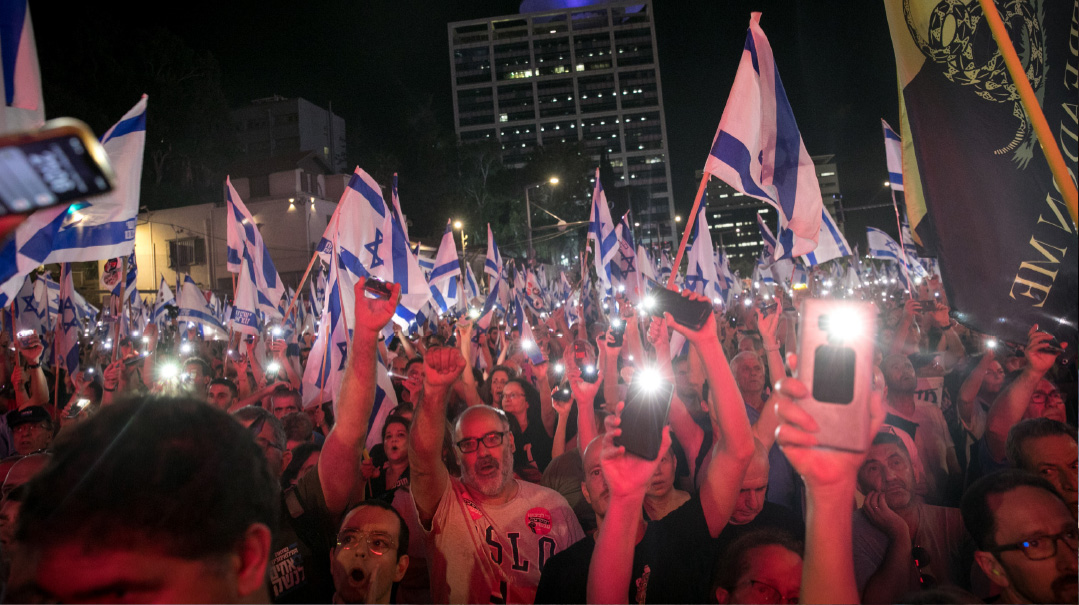
LIBERALISM FOR ME, NOT FOR THEE The weekly justice protests at Tel Aviv’s Kaplan Street
Religious Revival
Underlying the animosity is the sense that the religious people are interlopers, unwelcome in the great secular stronghold of Tel Aviv. But that definition of the city is historically illiterate, as can be seen from a glance at the map of central Tel Aviv. Within two minutes of Habima is the now-defunct Modzhitz shtibel. Behind Dizengoff Center is the Stoliner shtibel, and across the street from that is the Chug Chasam Sofer shul once populated by Oberlander Jews.
Within walking distance are the shuls belonging to Ger, Ozherov, Belz, Koidenov, and Skernevitch. Belz in particular was notable for choosing to make the city its home, as the great Rav Aharon Belzer preferred Tel Aviv over Jerusalem, because the former was a city without any churches.
“In the 1960s,” says David Shub, a third-generation chareidi Tel Avivian, Chevron Yeshivah graduate and practicing lawyer, “there were more chassidic courts in this city than in Bnei Brak.”
But it wasn’t a utopia back then either. A glance at the archives shows that Tel Aviv is no stranger to religious battles. A famous poster from 1933 headlined “Against Public Shabbos Desecration” and signed by Tel Aviv’s founding mayor, Meir Dizengoff, decries the mounting chillul Shabbos. “The situation pains and insults not just chareidim, but anyone who wants to see Tel Aviv as a mother-city in Israel, the successor of the Jewish centers of the exile.”
All of that changed in the 1970s, with the great flight of the religious public from the cramped and secularizing city to the suburbs and more religious climes.
But over the last decade, Tel Aviv has suddenly become noticeably more religious again. True, the spodiks of the Gerrer chassidim are an ever-rarer sight, but religious people are everywhere. Large numbers of baalei teshuvah are in the city’s south, and recently they’ve spread to the center, courtesy of Rav Mordechai Auerbach’s community.
A wave of French aliyah has brought higher culinary and kashrus standards to large parts of the city that until recently had not a single kosher restaurant.
Shub, who dedicates his legal services pro bono to battle for the return of historic shuls that were appropriated by the Municipality, has witnessed the comeback firsthand. “Ten years ago, there were still large shuls to be had for new organizations,” he says. “Now, for every small shtibel, I have five or six groups vying for its use.”
This religious comeback has triggered secular hostility. Chilonim-Yerukim, the Secular-Green Party, is a slate for the upcoming local elections headed by Tel Aviv Deputy Mayor Reuven Ladiansky. The slate’s manifesto calls for Tel Aviv to be granted autonomy from the rest of Israel, which is deemed too religious. The party is also campaigning for a city council free of “messianics” — a catch-all phrase for those of uncomfortably strong religious commitment.
For David Shub, whose Shabbos garb of suit and black hat is unusual in Tel Aviv’s affluent north, the ongoing political tensions have made him feel uncomfortable in his own city for the first time. “I’ve been spat at by protesters, and my son-in-law had his car window smashed.”
He doesn’t know whether what he terms the “psychosis” that has gripped the protest movement marks a permanent change in Israeli society, or will slowly ebb.
But the protests, he says, have created new challenges for religious life in the city. “We have 100 people coming to my shul for Selichos, including many nominally-secular people who’ve become involved over the years. I would say about half attend the protests before coming.”
Line of Command
Back in the Shuk HaCarmel, the morning crew are about to do their changing of the tefillin guards, as the avreichim give way to bochurim who will man the afternoon shift. But Tel Aviv isn’t in such a hurry: the reggae guy is still belting out his hits to an appreciative audience.
Amid a national battle of ideas, a struggle over Jewish identity in which they’ve unwillingly found themselves in the spotlight, the Chabad shlichim keep calm and carry on offering passersby a mitzvah and a smile.
Having seen Tel Aviv’s Tefillin Wars come and go, they — like the reggae singer — take the long view. They know that they’ll be back next week and the week after, amid the noise, color, and ever-shifting human tapestry of the shuk, and they know why they stand around in the heat of the midday sun each Erev Shabbos.
“Yes, we’re here on the frontline of a battle over Jewish identity,” Moishie Fleischman says, “but it’s more than that. For all the Jews we interact with — whether they end up putting on tefillin or not — we see these tefillin stands binding our people together.”
(Originally featured in Mishpacha, Issue 980)
Oops! We could not locate your form.







